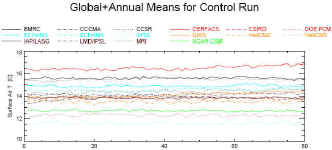
The Real 'Inconvenient Truth'
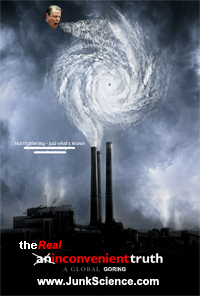
|
|
Click on the graphic above to retrieve a 600 x 889 pixel version (prints conveniently on A4 page) We admit we didn't expect the demand experienced for the poster-size graphic of 1300 x 1926 pixels, available for download here (585KB). We are not selling these images but your donations do help us provide the information that you came to this page to read. |
Some facts about greenhouse and global warming
JunkScience.com
Updated August 2007
These pages now hosted on JunkScienceArchive.com
Following requests from JunkScience.com readers we thought it might be a good idea to pull together a page of questions-and-answers, complete with a few nice little graphics explaining the facts.
Unfortunately there's a lot of rubbish available on the 'net giving rather misleading descriptions of Earth's natural 'greenhouse effect' and of the probable consequences of human-generated emissions adding to this effect.
Basic misconceptions that must be addressed include:
Does the Earth's atmosphere primarily behave like an actual greenhouse?
No. The term "greenhouse effect" is unfortunate since it results in a false impression of the activity of so-called "greenhouse gases." An actual greenhouse works as a physical barrier to convection (the transfer of heat by currents in a fluid) while the atmosphere really facilitates convection so the impression of actual greenhouse-like activity in the Earth's atmosphere is incorrect.
For a description of physical greenhouses see Sue Ann Bowling's ASF piece here.
This does seem to cause some confusion so, to highlight the distinction between actual greenhouses and Earth's inaccurately named greenhouse effect simply note that greenhouse temperatures are maintained by controlling the mixing air inside and outside the greenhouse (if it's too warm in the greenhouse you open a top and bottom window and let convective action displace warmed air with cool) while Earth's atmosphere is surrounded by the near-vacuum of space.
So, real greenhouses work mainly by modulating convection while the 'greenhouse effect' works by modulating radiation.
Are greenhouse gases like a blanket around the Earth?
No, for the same reason that they don't behave like an actual greenhouse, they simply do not behave as a barrier to convective activity and so aren't "like a blanket."
Forgetting about the unfortunate-but-commonly-used terminology for a moment, is the so-called 'greenhouse effect' bad?
No, it's necessary to maintain a habitable planet. Our moon, lacking greenhouse effect, makes a kind of comparison even though lack of atmosphere makes it uninhabitable regardless of temperature. The moon's mean surface temperature by day is 107 °C (380 K, 225 °F) and by night drops to -153 °C (120 K, -243 °F). The Lunar surface temperature increases about 260 °C from just before dawn to Lunar noon.
How much does the so-called 'greenhouse effect' warm the Earth?
It's estimated that the Earth's surface would be about -18 °C (0 °F, 255 K) with atmosphere and clouds but without the greenhouse effect and that the (we'll call it "natural") greenhouse effect raises the Earth's temperature by ~33 °C (59 °F).
We should note that devoid of atmosphere Earth would actually be a less-cold
The workings: thermal equilibrium for an Earth without an atmosphere:The sun behaves approximately like a black body of radius rs=6.599 x 105 Km, at a temperature of Ts=5,783 K. The radiative flux at the sun's surface is given by the expression σTs4, where σ is the Stefan-Boltzmann Constant (5.6704 x 10-8 Wm2K4). Flux refers to radiation per unit area. Thus, at the Earth's distance from the sun, res=1.496 x 108 Km, this flux is reduced by the factor (rs/res)2. The Earth's disk has a cross section, acs=πre2, where re is the Earth's radius (6.378 x 103 Km), and thus intercepts acsσTs4(rs/res)2 radiation from the sun. In order to balance this intercepted radiation, the Earth would warm to a temperature Te, where σTe44πre2 = acsσTs4(rs/res)2. This leads to a solution Te=272 K. Clouds, which obviously require an atmosphere, and other features of the Earth reflect 31% of the incident radiation. Taking this into account reduces Te to 255 K. |
Theoretically, if the planet's surface cooled by radiation alone, then the greenhouse-induced surface temperature would be much warmer, about 350 K (77 °C). Atmospheric motion (convective towers carrying latent and sensible heat upwards and large scale circulation carrying it both upwards and polewards) circumvent much of the greenhouse effect and significantly increase the "escape" of energy to space, leaving Earth's surface more than 60 °C cooler than a static atmosphere would do.
Additionally, greenhouse gases are only able to absorb radiation in very specific electromagnetic frequencies and Earth does not radiate limitless amounts of energy in the appropriate bandwidths. This means there is 'competition' for available energy and significant greenhouse potential is unrealized (carbon dioxide could absorb more than 3 times the energy it currently does in the atmosphere were it not for competition from clouds and water vapor, clouds alone could absorb 50% of available energy but manage to capture just 14% and so on...).
So, despite there being far more greenhouse gas in the atmosphere than required to achieve the current greenhouse effect, something which has been true since before humans discovered fire, evapo-transpiration and thermals transport heat higher in the atmosphere where radiation to space is increased. This is why Earth remains about 15 °C (288 K) rather than about 77 °C (350 K).
Wait a minute! Those aren't the numbers I learned!
Ah! Someone who remembers their science classes eh? Well, you got us. Reference works frequently list the planet's mean surface temperature as 16 °C (289 K, 61 °F); sometimes 15 °C (288 K, 59 °F) is mentioned and yes, these are about the expected temperatures by calculation -- in the 1960s and 1970s numbers as high as 65 °F (18 °C, 291 K) were popular but we haven't seen those for some time. Here we run into a little bit of a problem, however -- taking the Earth's temperature is no trivial task. In fact, even defining precisely what we mean by the absolute surface air temperature is challenging. Current global temperature anomalies (the amount of warming or cooling reported) are estimated against an expected average of 14 °C (287 K, 57 °F) -- the guess-timated mean temperature over the period 1961-1990.
Sidebar:One of the quirks of climate science is that climate models are frequently 'tuned' to reproduce the expected mean temperature of 287 K or 14 °C and, somewhat bizarrely, 14 °C is thought to be the correct figure because 'the most trusted models produce it'. While the average of model representations of global climate suggests Earth's mean temperature is about 14 °C (287 K), the 16 most trusted and 'stable' models tested in the Coupled Model Intercomparison Project (CMIP) (see original .pdf) are not well able to reproduce this result.
The absolute mean surface air temperature of the Earth is actually not known and there is no specification of exactly what we are trying to measure or how to go about doing so. No one knows what Earth's optimal temperature would be or how it could be knowingly and predictably adjusted even if an optimum could be agreed. |
Do greenhouse gases trap the sun's radiation/'heat'?
Not to any great extent. The Sun, being much hotter than Earth, emits high energy, shortwave radiation while in response Earth emits longwave radiation. The cooler the portion of the Earth or atmosphere, the lower energy intensity, longer wave radiation is emitted (that old white hot, yellow hot, red hot thing).
Greenhouse gases are generally transparent to incoming solar radiation (they let most solar radiation through) and opaque to Earth's radiation (they absorb and transfer the Earth's infrared radiation by a variety of means). That said, oxygen and ozone do absorb incoming Ultraviolet (UV) radiation (<0.3?m) and water, ozone, oxygen and, to a tiny extent, carbon dioxide also absorb a small amount of incoming shortwave below the 3 micron (?m) wavelength range (see graphic) and it is mostly the UV absorption by ozone that causes warming in the stratosphere above the tropopause.
The tropopause is the boundary between the troposphere (which is based at the earth's surface and has temperature that decreases with height, extending about 10-50Km or 6-30 miles above the surface) and the stratosphere (which is a stable region of very low levels of vertical mixing above the troposphere).
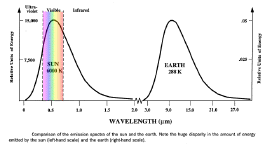 A representation of relative emission
wavelengths can be seen on the following graphic.
A representation of relative emission
wavelengths can be seen on the following graphic.
Greenhouse gases do not really "trap Earth's heat" but could be fairly described as delaying the energy transfer from Earth to space. ("Trapping heat" implies that the energy is stuck in the system forever, which is a false notion.) Greenhouse gases do not emit energy in the same bandwidth in which they absorb energy and thus emissions from carbon dioxide are not absorbed by carbon dioxide.
While energy may be delayed on its inevitable journey back to space, it will eventually be emitted regardless of the number of intervening stages.
Is 'greenhouse' the same as 'global warming'?
Absolutely not. We'll look at both terms below.
What about 'climate change' then?
That's a different thing altogether. Change is what the climate is always doing and is the result of our planet's orbital eccentricities, axial wobble, solar brightness variation, cosmic ray flux, etc.. There are also plausible terrestrial drivers of climate change too, including super volcanic events and tectonic movement, but these are not in the realm of anthropogenic (manmade) effects and so we won't looking at them here.
The global mean temperature over which there has been so much obsession is only one part of climate (for example, how wet or dry the climate happens to be is probably of far greater significance than a simple mean temperature). In fact it's not even clear that a global mean temperature is a particularly useful metric. Nonetheless Earth's apparent temperature is the cause of great angst at present so it will remain the focus of this document for that reason alone.
Graphics for a simple understanding of the greenhouse effect
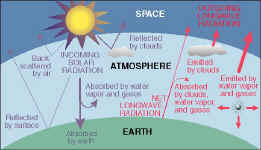 This first graphic meets the criteria of being simple, specifically includes water vapor and clouds as both absorbers
and emitters (remarkably few greenhouse graphics do so) and is reasonably proportionate.
This first graphic meets the criteria of being simple, specifically includes water vapor and clouds as both absorbers
and emitters (remarkably few greenhouse graphics do so) and is reasonably proportionate.
Big note here -- we were unable to find useful graphics adequately expressing convection, which, as we highlighted above, keeps the planet more than 60 °C cooler than would otherwise be the case.
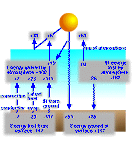 The next graphic provides an indication of the infrared component of the planetary radiation budget. Note that these
are expressed as percentages and that the 100% incoming and outgoing solar energy balance is not the whole story -- there is additional energy transfer
in progress between the atmosphere and surface, and surface and atmosphere. This is the natural greenhouse effect that makes life as we know it possible on
Earth. (Don't worry if you don't quite follow the numbers, we'll provide a "map" view below.)
The next graphic provides an indication of the infrared component of the planetary radiation budget. Note that these
are expressed as percentages and that the 100% incoming and outgoing solar energy balance is not the whole story -- there is additional energy transfer
in progress between the atmosphere and surface, and surface and atmosphere. This is the natural greenhouse effect that makes life as we know it possible on
Earth. (Don't worry if you don't quite follow the numbers, we'll provide a "map" view below.)
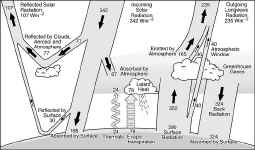 The following is from Earth?s Annual Global Mean Energy Budget (Kiehl and
Trenberth, 1997). This is expressed in Watts per square meter (Wm-2) and tells the same story of the incoming 342 Wm-2 = outgoing (235 +
107 Wm-2). Note that there is relatively little direct reflection and radiation from surface to space but significant exchange via the atmosphere.
Note further that the surface receives almost twice the energy from the atmosphere as it does directly from the sun. The exchange between surface, atmosphere
and surface is what is meant by greenhouse effect. (Some might prefer viewing this
simplified Earth energy budget)
The following is from Earth?s Annual Global Mean Energy Budget (Kiehl and
Trenberth, 1997). This is expressed in Watts per square meter (Wm-2) and tells the same story of the incoming 342 Wm-2 = outgoing (235 +
107 Wm-2). Note that there is relatively little direct reflection and radiation from surface to space but significant exchange via the atmosphere.
Note further that the surface receives almost twice the energy from the atmosphere as it does directly from the sun. The exchange between surface, atmosphere
and surface is what is meant by greenhouse effect. (Some might prefer viewing this
simplified Earth energy budget)
It might also help novices to conceive of the atmosphere and the natural greenhouse effect as a kind of metaphorical energy flow control valve. There is a lot of energy bouncing around but the amount of energy entering the system and the amount leaving is fairly tightly constrained. The atmosphere is acting as a kind of check valve, slowing the loss of energy to space but the net incoming (324 + 168 Wm-2) = net outgoing (390 + 78 + 24 Wm-2).
Okay, if that's greenhouse, what is 'global warming'?
While greenhouse is the "what," "global warming" really refers to the "how much."
Since Arrhenius began speculating a century ago about low CO2 levels and ice ages the hypothesis of temperature relation to atmospheric carbon dioxide has drifted in and out of scientific focus. At present it is the focus of a great deal of attention.
Populist overuse and abuse has largely rendered the term "global warming" meaningless and what is really meant is "enhanced greenhouse". Yes, this is another term but don't worry, we'll explain this one easily and quickly.
"Enhanced greenhouse" means the additional delay in energy loss to space induced by the fraction of carbon dioxide and other greenhouse gases released by humans before those gases are removed from the atmosphere by breakdown and/or biological activity.
So, greenhouse is all about carbon dioxide, right?
Wrong. The most important players on the greenhouse stage are water vapor and clouds. Carbon dioxide has been increased to about 0.038% of the atmosphere (possibly from about 0.028% pre-Industrial Revolution) while water in its various forms ranges from 0% to 4% of the atmosphere and its properties vary by what form it is in and even at what altitude it is found in the atmosphere.
In simple terms the bulk of Earth's greenhouse effect is due to water vapor by virtue of its abundance. Water accounts for about 90% of the Earth's greenhouse effect -- perhaps 70% is due to water vapor and about 20% due to clouds (mostly water droplets), some estimates put water as high as 95% of Earth's total tropospheric greenhouse effect (e.g., Freidenreich and Ramaswamy, ?Solar Radiation Absorption by Carbon Dioxide, Overlap with Water, and a Parameterization for General Circulation Models,? Journal of Geophysical Research 98 (1993):7255-7264).
The remaining portion comes from carbon dioxide, nitrous oxide, methane, ozone and miscellaneous other "minor greenhouse gases." As an example of
the relative importance of water it should be noted that changes in the relative humidity on the order of 1.3-4% are equivalent to the effect of doubling CO2.
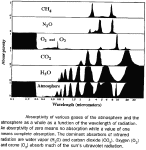 The adjacent radiation absorption window graphic gives an idea of which molecules absorb various wavelengths.
The adjacent radiation absorption window graphic gives an idea of which molecules absorb various wavelengths.
Where the shaded portions completely span between 2 lines it indicates that particular wavelength is fully absorbed and the "window" is saturated (or said to be "closed"). Once a window approaches saturation adding more gases with the same properties will do nothing exciting.
This point seems to cause a bit of confusion for some people so perhaps consider multiple shades on a window with each shade blocking half the light coming through. Pull one shade and you reduce the light source by half, pull another and you block half the light coming through the first shade, etc.. The effect of each shade diminishes as you keep adding more until eventually you get no additional effect - you have saturated or blocked the radiation window and it makes no real difference if you double or quadruple the number of shades again.
Well, I heard that carbon dioxide is bad -- it's pollution, isn't it?
There seem to be a few things that your informant forgot to tell you -- like carbon dioxide being an essential trace gas that underpins the bulk of the global food web.
Estimates vary, but somewhere around 15% seems to be the common number cited for the increase in global food crop yields due to aerial fertilization with increased carbon dioxide since 1950. This increase has both helped avoid a Malthusian disaster and preserved or returned enormous tracts of marginal land as wildlife habitat, land that would otherwise have had to be put under the plow in an attempt to feed the growing global population.
Commercial growers deliberately generate CO2 and increase its levels in agricultural greenhouses to between 700ppmv and 1,000ppmv to increase productivity and improve the water efficiency of food crops far beyond those in the somewhat carbon-starved open atmosphere. CO2 feeds the forests, grows more usable lumber in timber lots meaning there is less pressure to cut old growth or push into "natural" wildlife habitat, makes plants more water efficient helping to beat back the encroaching deserts in Africa and Asia and generally increases bio-productivity.
If it's "pollution," then it's pollution the natural world exploits extremely well and to great profit. Doesn't sound too bad to us.
But we're responsible for all the carbon dioxide greenhouse effect?
Gracious no! Humans can only claim responsibility, if that's the word, for abut 3.4% of carbon dioxide emitted to the atmosphere annually, the rest of it is all natural (you can see the IPCC representation of the natural carbon cycle and human perturbation here or a simple schematic from Woods Hole here).
Half our estimated emissions fail to accumulate in the atmosphere, "disappearing" into sinks as yet undetermined. Humans' total accumulated carbon contribution could account for perhaps a quarter of the total non-water greenhouse gases (that is, accounting for all the increase since the Industrial Revolution regardless of source and irrespective of whether warming from any cause might result in an increase in natural emission to atmosphere -- we're simply claiming the lot as anthropogenic or human-caused here).
Assuming that water vapor accounts for about 70% and clouds (mostly water droplets) accounts for another 20%, thus water in it's various forms is 90% of the total greenhouse effect, leaving 10% for non-water greenhouse effect (we know we cited 95% above -- see "important distinction"). Of this remaining 10%, mainly atmospheric carbon, humans might be responsible for 25% of the total accumulated atmospheric carbon, meaning 0.25 x 0.1 = 0.025 x 100 = 2.5% of the total greenhouse effect.
Ah, we've added 2.5% to the total greenhouse effect then?
Well, not exactly, if it were such a simple accumulation we could easily determine exactly how much Earth would warm from a doubling of atmospheric CO2 (not much) and certainly that would be an improvement on the silly figures bandied about.
Theoretically, in a dry atmosphere, carbon dioxide could absorb about three times more energy than it actually does. Clouds, in the absence of all other greenhouse gases, could do likewise -- look at it as there already being "competition" for available suitable longwave radiation (energy these gases can absorb), if you like.
Readers should be aware that the temperature effect of atmospheric carbon dioxide is logarithmic (that means there is a diminishing response as you keep adding more, like the additional window shade example, above).
If we consider the warming effect of the pre-Industrial Revolution atmospheric carbon dioxide (about 280 parts per million by volume or ppmv) as 1, then the first half of that heating was delivered by about 20ppmv (0.002% of atmosphere) while the second half required an additional 260ppmv (0.026%).
To double the pre-Industrial Revolution warming from CO2 alone would require about 90,000ppmv (9%) but we'd never see it - CO2 becomes toxic at around 6,000ppmv (0.6%, although humans have absolutely no prospect of achieving such concentrations).
Well, how much does carbon dioxide heat the Earth?
Oh my, we were afraid you were going to ask that. Because so many of the atmospheric processes are still being sorted out and quantified this is a non-trivial task. But alright, here goes.
What we can do is plot some of the more common estimates -- note that these are something of a curve-fitting exercise on our part because we don't have the full papers and workings at hand. Stay with us while we run through a couple of rough sketch graphs, following which we'll try a different approach to see if we can't narrow the possibilities.
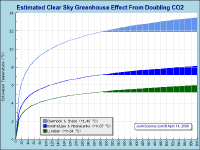 We'll
offer three of the more commonly used and/or discussed estimates for the amount of cooling Earth would experience for a hypothetical zero-CO2,
cloud-free atmosphere
We'll
offer three of the more commonly used and/or discussed estimates for the amount of cooling Earth would experience for a hypothetical zero-CO2,
cloud-free atmosphere
- Lindzen (5.3 °C clear sky, 3.53 °C with 40% cloud),
- Charnock & Shine (12 °C clear sky), C&S are the big number guys in the estimation game (both these from Physics Today, 1995),
- Kondratjew & Moskalenko (7.2 °C, commonly cited but we are not sure why, perhaps because Houghton used their estimate in his book, 'The Global Climate', 1984).
Here these estimates are simply scripted up to produce the following graphs and the numbers are imprecise, merely adequate to give everyone a reasonable look at how carbon dioxide fits into the picture.
Note also that there is still dispute over whether water would (does) act as a positive or negative "feedback" (multiplier effect) since water vapor and droplets (clouds) affect both incoming Solar radiation and outgoing Earth radiation.
Our simple script is logarithmic (remember our example of adding more shades over a window) but does not allow for complete saturation of radiative wavelengths, likely increases in evapo-transpirative cooling, increases in albedo (bright clouds reflecting more incoming solar radiation) nor any variation by latitude and so will progressively overestimate potential warming from CO2 alone. No matter, it does quite well enough to demonstrate the principle.
You can see how much this little script has overshot the mark since Lindzen states explicitly that a doubling from 300ppmv to 600ppmv of atmospheric carbon dioxide would result in only 0.5 °C warming. Rather obviously, Lindzen's calculations do not suggest a particularly large greenhouse influence on post-Industrial Revolution temperatures and, significantly, this does not include clouds, so CO2 would really only be a fraction of the total effect shown (Lindzen states 0.22 °C if calculated with 40% cloud cover).
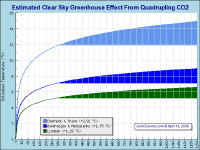 Despite
our over-estimation of the numbers on the graph it should be apparent there is only moderate warming potential from carbon dioxide emissions. These have all
been plotted simultaneously so you can see the range of estimates for incremental change in temperature driven by greenhouse gases and below we show for a
quadrupling of CO2-equivalent greenhouse gas relative to pre-Industrial Revolution levels.
Despite
our over-estimation of the numbers on the graph it should be apparent there is only moderate warming potential from carbon dioxide emissions. These have all
been plotted simultaneously so you can see the range of estimates for incremental change in temperature driven by greenhouse gases and below we show for a
quadrupling of CO2-equivalent greenhouse gas relative to pre-Industrial Revolution levels.
Since some people are not familiar with logarithmic effect, we'll just point out a few features from the above graphs. Note the diminishing effect in all cases -- the first half of pre-IR greenhouse-driven temperature increment in each estimate is achieved by less than 20 parts per million carbon dioxide (20ppmv CO2), it then took adding thirteen times as much again to repeat the performance (to 280ppmv). The estimated temperature increment range for a doubling of pre-IR CO2 (graphed as 300ppmv to 600ppmv) is just +0.6 °C to +1.5 °C and for a quadrupling (to 1200ppmv) +1.3 °C to +2.9 °C.
Lots of numbers, which ones fit what we think we know of the Earth's greenhouse effect?
Let's try working backwards for a moment.
The Earth's greenhouse effect is commonly estimated at 33 °C and these calculations simply assume that to be true.
If water vapor accounts for 70% and clouds another 20% (making water 90% of total atmosphere greenhouse effect) then we have 10% left for carbon dioxide and the ubiquitous "other" GHGs.
Lindzen's 3.53 °C cooling potential for complete removal of CO2 would then seem to fit the bill fairly adequately at around 10.7% of the total effect (3.53/33), while there's really not room for the larger estimates. Note, however, that carbon dioxide is generally reckoned to account for between 4.2% and 8.4% of Earth's net greenhouse effect because water vapor and clouds also behave differently at different concentrations and temperatures (we warned you this wasn't linear).
On the other hand, if we assume Charnock and Shine are closer to the mark then ~36% of Earth's greenhouse effect must be driven by CO2 (12/33).
This is intuitively unreasonable since water is both prolific and has absorption windows overlapping those of carbon dioxide to a large extent.
|
Water covers more than 70% of the globe and the lower atmosphere over water tends to be relatively well supplied with water both as vapor and clouds. Water is the dominant absorber in wavelengths expected in the warmer regions, such as in the tropics where water is hugely prolific and where significant greenhouse warming occurs. It simply does not seem reasonable to expect CO2 to preferentially absorb more than one-third of the available energy. |
This suggests (but does not prove) that Lindzen is likely to be the nearest estimate from those we've plotted above.
Note that if you discount all other possible drivers of global temperature change -- meaning that humanity has completely taken over from all natural effects that were operating until that time (highly unlikely) -- then the estimate of Charnock & Shine neatly fits observed warming over the period.
If their massive estimate of net greenhouse effect from carbon dioxide is true then a worst case doubling of atmospheric carbon dioxide will still only produce a total warming under 1.5 °C (and we're thought to be almost half-way there already).
This still does not suggest a major enhanced greenhouse catastrophe.
What about the 'positive feedback' they talk about -- what's that?
Positive feedback is a multiplier effect, usually 2.5 times, added to models to make them 'wiggle fit' (reproduce previously observed temperatures) with the
limited set of parameters programmed.
CLIMATE SENSITIVITY"The sensitivity of the climate system to a forcing is commonly expressed in terms of the global mean temperature change that would be expected after a time sufficiently long for both the atmosphere and ocean to come to equilibrium with the change in climate forcing. If there were no climate feedbacks, the response of Earth's mean temperature to a forcing of 4 W/m2 (the forcing for a doubled atmospheric CO2) would be an increase of about 1.2 °C (about 2.2 °F). However, the total climate change is affected not only by the immediate direct forcing, but also by climate ?feedbacks? that come into play in response to the forcing." "As just mentioned, a doubling of the concentration of carbon dioxide (from the pre-Industrial value of 280 parts per million) in the global atmosphere causes a forcing of 4 W/m2. The central value of the climate sensitivity to this change is a global average temperature increase of 3 °C (5.4 °F), but with a range from 1.5 °C to 4.5 °C (2.7 to 8.1 °F) (based on climate system models: see section 4). The central value of 3 °C is an amplification by a factor of 2.5 over the direct effect of 1.2 °C (2.2 °F). Well-documented climate changes during the history of Earth, especially the changes between the last major ice age (20,000 years ago) and the current warm period, imply that the climate sensitivity is near the 3 °C value. However, the true climate sensitivity remains uncertain, in part because it is difficult to model the effect of feedback. In particular, the magnitude and even the sign of the feedback can differ according to the composition, thickness, and altitude of the clouds, and some studies have suggested a lesser climate sensitivity." Climate Change Science: An Analysis of Some Key Questions, pp 6-7, "Climate models calculate outcomes after taking into account the great number of climate variables and the complex interactions inherent in the climate system. Their purpose is the creation of a synthetic reality that can be compared with the observed reality, subject to appropriate averaging of the measurements. Thus, such models can be evaluated through comparison with observations, provided that suitable observations exist. Furthermore, model solutions can be diagnosed to assess contributing causes of particular phenomena. Because climate is uncontrollable (albeit influenceable by humans), the models are the only available experimental laboratory for climate. They also are the appropriate high-end tool for forecasting hypothetical climates in the years and centuries ahead. However, climate models are imperfect. Their simulation skill is limited by uncertainties in their formulation, the limited size of their calculations, and the difficulty of interpreting their answers that exhibit almost as much complexity as in nature." Climate Change Science: An Analysis of Some Key Questions, p 15, |
Due to the enormous complexity of the atmosphere and the initial conditions that must be set, ranging from solar output to the texture of the Earth's surface and its effect on wind speed, seasons, humidity, cloudiness, ocean currents and so on, models are necessarily vastly simplified compared with the real world and hence need many compromises and fudges.
Since the known physics of carbon dioxide when modeled with measured Twentieth Century changes do not produce sufficient swings to match measured 20th Century temperature trends a multiplier of 2.5 is used (said to account for increased evaporation in a slightly warmer world which, in turn, produces more water vapor greenhouse effect and more warming...).
Sounds reasonable -- we did say water vapor was the most important greenhouse gas
Yes and no. While it is intuitively reasonable that the most prolific and important greenhouse gas could act as a magnifier there is no evidence that it does. In fact water vapor is self limiting because it precipitates out as rain and snow and its effect also varies as cloud, with more bright low cloud acting as a cooling effect.
If positive feedback from water vapor was really a dominant climatic effect then it should be very easy to find, firstly by looking at an unusual event.
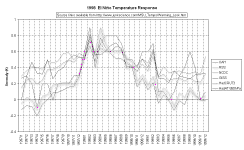 Depicted in the adjacent graphic is Earth's response to the 1997/98 El Ni? event.
These are anomalies and several of the datasets produce anomalies with reference to different base periods but that is of no particular interest here -- only
the synchronous warming and subsequent cooling depicted in the atmospheric series (UAH and RSS satellite, HadAT radiosonde balloon) and near-surface land and
sea surface datasets (NCDC, GISS and HadCRUT3) of ~0.9 and ~0.5 K respectively.
Depicted in the adjacent graphic is Earth's response to the 1997/98 El Ni? event.
These are anomalies and several of the datasets produce anomalies with reference to different base periods but that is of no particular interest here -- only
the synchronous warming and subsequent cooling depicted in the atmospheric series (UAH and RSS satellite, HadAT radiosonde balloon) and near-surface land and
sea surface datasets (NCDC, GISS and HadCRUT3) of ~0.9 and ~0.5 K respectively.
This warming and subsequent cooling is in addition to the normal seasonal global variation (plotted as variation from the expected monthly mean temperature in each case) and thus provides precisely the situation in which we are interested.
Since the world cooled almost as abruptly as it warmed we can only assume no positive feedback mechanism was invoked and thus Earth is not perilously perched upon some critical temperature threshold beyond which new physics takes over and runaway enhanced greenhouse warming becomes a self-perpetuating nightmare. That test for a multiplier effect surely failed.
Secondly, we know there's an annual warming, quite a severe one, in fact and that's the seasonal heating of the hemispheres. Since the Northern Hemisphere contains the greatest proportion of landmass and land heats more than oceans the Northern Hemisphere summer season causes significant increase in the global mean temperature:
This is as reported by the National Climatic Data Center, the means 1961-1990 (commonly used as a reference period) work out the same globally but do differ slightly on a regional basis:
|
Combined Mean Surface Temp. |
JAN |
FEB |
MAR |
APR |
MAY |
JUN |
JUL |
AUG |
SEP |
OCT |
NOV |
DEC |
Annual |
|
1880 to 2004 (?C) |
12.0 |
12.1 |
12.7 |
13.7 |
14.8 |
15.5 |
15.8 |
15.6 |
15.0 |
14.0 |
12.9 |
12.2 |
13.9 |
|
1880 to 2004 (?F) |
53.6 |
53.9 |
54.9 |
56.7 |
58.6 |
59.9 |
60.4 |
60.1 |
59.0 |
57.1 |
55.2 |
54.0 |
57.0 |
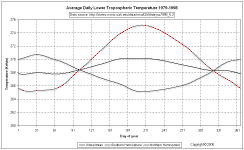 There is always the possibility this temperature effect is a seasonal artifact of
near-surface measurement so we should check atmospheric measures. UAH MSU data tells us the lower troposphere global mean varies somewhat less than near-surface
temperature with monthly averages rising and falling approximately 2.3 °C through the year (there's no significant difference between UAH and RSS lower tropospheric data).
There is always the possibility this temperature effect is a seasonal artifact of
near-surface measurement so we should check atmospheric measures. UAH MSU data tells us the lower troposphere global mean varies somewhat less than near-surface
temperature with monthly averages rising and falling approximately 2.3 °C through the year (there's no significant difference between UAH and RSS lower tropospheric data).
The Northern Hemisphere (where most people live) cycles an impressive 9.76 °C through the monthly averages as far as lower tropospheric measures are concerned and a whopping 11.6 °C according to land-based near-surface measures.
With global and hemispheric variation to this extent each and every year it is somewhat difficult to view an estimated change of
Nonetheless, the global troposphere warms at least 2 K from January to July every year without triggering any self-perpetuating water vapor-driven positive feedback. Surely a positive feedback should manifest under the influence of a 10 K hemispheric warming and this should be sufficient to overwhelm lack of insolation in the Southern Hemisphere winter inducing global warming and yet this doesn't happen. So much for 'positive feedback.
If that's all the anticipated greenhouse effect, where do the big warming estimates come from?
Ah, this is where it gets rather contentious because the big warming numbers come not from measurements but from computer models. These computer models and their output are passionately defended by the modeling clique and frequently derided by empiricists -- but the bottom line is that models make an enormous range of assumptions. Whether all the assumptions, tweaks and parameter adjustments really collectively add up to a realistic representation of the atmosphere is open to some conjecture (current climate models do not model "natural" climatic variation very well), but there is no evidence yet that they can predict the future with any greater certainty than a pack of Tarot cards.
Moreover, humans do a lot besides emitting greenhouse gases, changing vegetation and transpiration rates through agriculture, for example, and many effects expected to both increase and decrease regional temperatures are not included in these models.
Regardless, climate models are made interesting by the inclusion of "positive feedbacks" (the multiplier effects mentioned above) so that a small temperature increment expected from increasing atmospheric carbon dioxide invokes large increases in water vapor, which seem to produce exponential rather than logarithmic temperature response in the models. It appears to have become something of a game to see who can add in the most creative feedback mechanisms to produce the scariest warming scenarios from their models but there remains no evidence the planet includes any such effects or behaves in a similar manner.
There has been some claim we are ignoring "self-evident" positive feedbacks, which we'd be delighted to highlight if only someone could point to
any such empirical measure. The bottom line, however, is that the IPCC estimates a trivial
It is evident, to us at least, that if positive feedback mechanisms exist (entirely plausible) then their effect is negligible or mitigated by negative feedback mechanisms (equally plausible). Unlike modelers, who alter their virtual worlds at whim, we can only measure what the world actually does, and there simply isn't room in the measured change for the existence of significant unmitigated positive feedbacks.
As an example of how mileage may vary, as they say, we've reproduced here a table of comparisons between 108 model guess-timations for a doubling of atmospheric carbon dioxide compiled by Kacholia and Reck, published in 1997.
Note that the range of estimates spans from 0.2 °C to 8.7 °C and that the same modelers get large variations as they play with their model
parameters. For example Washington and Meehl show listings of 1.3 °C; 1.4 °C?3.5 °C; 1.6 °C; 4.0 °C and back to 1.6 °C over
the course of a decade. This is not highlighted as being egregious or any such thing, just frequent in this list. Charnock and Shine appear in this list (1993)
with estimations of 1.5 °C?2.4 °C and we derive their 1995 discussion in Physics Today as 1.46 °C so we're in the ballpark and they may
have reduced their estimate. Lindzen seems to have done so too, listed here from 1982 as 1.46 °C?1.93 °C and stating explicitly in the same Physics
Today discussion that he estimated 0.5 °C for clear sky conditions and just 0.22 °C when including 40% cloud cover.
Unfortunately there has been no narrowing of the estimated range of "expected" warming from a doubling of CO2 -- in fact the range has
widened even further as ever more players attempt to stand out in a crowded publication field. It isn't that the physics of carbon dioxide's radiative
properties keep changing, rather that ever more imaginative "feedbacks" are shunted into the positive column to make model output more interesting.
The bottom line is that you need to stuff a huge amount of CO2 into the atmosphere to get much response as more of the absorptive bands near
saturation.
The modelers themselves point out that their models continue to suffer significant difficulties: ModelE [2006] compares the atmospheric model climatology with observations. Model shortcomings include ~25% regional deficiency of summer stratus cloud
cover off the west coast of the continents with resulting excessive absorption of solar radiation by as much as 50 W/m2, deficiency in absorbed solar radiation
and net radiation over other tropical regions by typically 20 W/m2, sea level pressure too high by 4-8 hPa in the winter in the Arctic and 2-4 hPa too low in
all seasons in the tropics, ~20% deficiency of rainfall over the Amazon basin, ~25% deficiency in summer cloud cover in the western United States and central
Asia with a corresponding ~5?C excessive summer warmth in these regions. In addition to the inaccuracies in the simulated climatology, another shortcoming
of the atmospheric model for climate change studies is the absence of a gravity wave representation, as noted above, which may affect the nature of interactions
between the troposphere and stratosphere. The stratospheric variability is less than observed, as shown by analysis of the present 20-layer 4?x5? atmospheric
model by J. Perlwitz [personal communication]. In a 50-year control run Perlwitz finds that the interannual variability of seasonal mean temperature in the
stratosphere maximizes in the region of the subpolar jet streams at realistic values, but the model produces only six sudden stratospheric warmings (SSWs) in 50
years, compared with about one every two years in the real world. ... Climate
simulations for 1880-2003 with GISS modelE-- Hansen et al. 2007, in press. Actually, you can play with some parameters and work it out for yourselves. Since the really big guesses made by the IPCC and some truly bizarre output by
climateprediction.net (CPN) are at least linear, if not exponential in their response to changes in minor trace gases we can work backwards and below you will
find a pair of calculators so you can have a go.
Even before we managed to post this poor old CPN suffered a major embarrassment: Error
discovered in the BBC Climate Change Experiment. Now even they know they're wildly over-guess-timating. The BBC is advising those they dragooned into the
project that their model runs will be restarting here. Meanwhile, Red Tops like The Inquirer are mischievously postulating "With around 200,000 PCs running the experiment
non-stop for two months, it looks very much as if the BBC experiment is making more of a contribution to global warming than scientific knowledge."
Fortunately, the real world is not so easily perturbed.
Below, at left we have a linear calculator. To know how it works you just have to remember that the Earth is about 15 °C, so that's the output target
you are aiming at producing at the bottom of the calculator. You know that carbon dioxide accounts for something less than 10% of the Earth's greenhouse effect
so your first input is going to be a number less than or equal to that (in fact, we've limited the calculator so any greater input will be calculated as 10% and
it will ignore any attempted input that is not greater than zero). The second parameter is the guess-timated warming. The output produced will be what the current
global mean temperature must be for the linear increase to be as input.
At right we have a logarithmic calculator so you can play with the atmosphere to your heart's content. The calculator will always assume a base of 33 °C
for the starting net greenhouse effect - it's limited to a max of 10% greenhouse effect from CO2 and a minimum of 2ppmv CO2 so you can
really have a play with the atmosphere and logarithmic effect. Notice how doubling small concentrations of carbon dioxide gives large responses while the
reverse also applies - enjoy! When you are finished we have some more information below the calculators. How did you go? No? Oh well, try 4.2% of greenhouse effect for a net warming of 1.4 °C for the linear calculator.
Who says it is warming catastrophically?
Humans have only been trying to measure the temperature fairly consistently since about 1880, during which time we think the world may have warmed by about We are pretty sure it was cold before the 1880 commencement of record and we would probably not handle the situation too well if such conditions returned but
there has been no demonstrable catastrophic warming while people have been trying to measure the planet's temperature.
If we have really been measuring a warming episode as we think we have, then setting new records for "hottest ever in recorded history" should
happen just about every year -- although half a degree over a century is hardly something to write home about -- so there's really nothing exciting about
scoring the highest number when looking at such a short history.
The land temperature-only data (less than 30% of the planet and usually measured around cities) yields a trend of 0.07 °C/decade over the same period
for a total increment of 0.875 °C.
While we are talking about thermometry and measured near-surface temperatures we must underline that these accumulate to mere estimates and are fraught with
difficulties.
Seven-tenths of the globe's surface is water and historical temperature series from these regions are largely based on sailors tossing a bucket on a rope
over the side and then dangling a thermometer in the water hauled aboard, so coverage is basically from sea lanes and measurement somewhat, shall we say,
agricultural.
Then there's the problems introduced by discontinuity in local records as observation points move over time or small towns cease to exist altogether, even
gardens or the growth of adjacent trees might influence how air flows around a specific recording point and then there's changes in equipment to take into
account.
Calculating what the temperature is, let alone what it has been, is no trivial task and then accumulating myriad changing locales to a global amalgam leaves
much room for error.
To what extent UHIE is influencing the global temperature trends we think we are measuring remains uncertain. Although curators of global temperature
datasets tend to claim the effect has been eliminated through adjustments to the record, or that it is irrelevant, such claims are not entirely convincing.
What caused the apparently massive temperature leap at the beginning of the 18th Century? It certainly wasn't industrialization, that hadn't
happened yet. If such changes appear in the record during recent periods when people can not have caused them then they are by definition "natural"
and, if such natural changes are evident in recent history, why are we so fixated on carbon dioxide as a "culprit" driving lesser warming now?
Finally, it is worth wondering why, with some three and one-half centuries of population growth, development and urbanization depicted in the Central England
Temperature series, recent "chart-toppers" have managed to elevate top temperatures by a paltry 0.16 °C over those of the early 1730s.
The vast majority of increase in atmospheric carbon dioxide has taken place over the seventy years since the Second World War and if CO2 were a
significant driver of temperature change we would expect those years to be almost exclusively represented in the highest temperatures and yet fewer than half
manage to make the warmest one-hundred list.
The post hoc ergo propter hoc association of carbon dioxide is observed to increase, warmer temperatures are measured, therefore carbon dioxide warms
the planet is a very poor basis for the current fixation.
Whoa! We didn't say that at all.
This discussion is on greenhouse effect and possible enhanced greenhouse, but that's a long way from anthropogenic effect in total. Whether or not they
really affect global mean temperature, human endeavors have significant local effects.
The heat island effect mentioned above or the local effect of increased water vapor from large scale irrigation schemes would be good examples. Then there's
land use change which can be variable depending on latitude -- replacing dark forest with wheat fields might significantly affect local albedo and cooling one
region while denying shade in a more heavily irradiated region might cause ground heating through increased absorption.
There are many effects in a hugely complex system, some will be negative, some positive and all represent change, although that is neither good nor bad in
and of itself. That humans affect the region of their activities is true -- that enhanced greenhouse from human activity is known to be a current or imminent
catastrophe is not. And this document is only dealing with greenhouse effect and "global warming." Water vapor and carbon dioxide are major greenhouse gases.
Water vapor accounts for about 70% of the greenhouse effect, carbon dioxide somewhere between 4.2% and 8.4%.
Much of the wavelength bands where carbon dioxide is active are either at or near saturation.
Water vapor absorbs infrared over much the same range as carbon dioxide and more besides.
Clouds are not composed of greenhouse gas -- they are mostly water droplets -- but absorb about one-fifth of the longwave radiation emitted by Earth.
Clouds can briefly saturate the atmospheric radiation window (8-13?m) through which some Earth radiation passes directly to space (those hot and sticky
overcast nights produce this effect - that is greenhouse but has nothing to do with carbon dioxide).
Greenhouse gases can not obstruct this window although ozone absorbs in a narrow slice at 9.6?m.
Adding more greenhouse gases which absorb in already saturated bandwidths has no net effect.
Adding them in near-saturated bands has little additional effect. Finally, here's a palm-size reference version for those pub trivia nights.
So, now you know.
Copyright © 2006 JunkScience.com - All Rights Reserved
Principal Model Deficiencies
Why do we suspect the big warming numbers are likely wrong?
Well, why is the planet warming so catastrophically if it's not CO2 then?
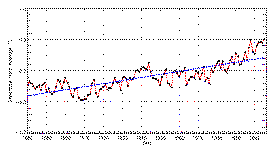 At risk of belaboring the point, the following
data is from the merged land air and sea surface temperature data set (based on data from the Global Historical Climatology Network (GHCN) of land
temperatures and the Comprehensive Ocean-Atmosphere Data Set (COADS) of SST data). This is the Time series: Temperature January-December, 1880 - 2005: Global
Trend: 0.04 °C/decade (for the arithmetically-challenged that's 12.5 decades for a total of +0.5 °C since 1880).
At risk of belaboring the point, the following
data is from the merged land air and sea surface temperature data set (based on data from the Global Historical Climatology Network (GHCN) of land
temperatures and the Comprehensive Ocean-Atmosphere Data Set (COADS) of SST data). This is the Time series: Temperature January-December, 1880 - 2005: Global
Trend: 0.04 °C/decade (for the arithmetically-challenged that's 12.5 decades for a total of +0.5 °C since 1880).
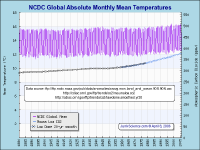 A lot of people seem to like an idea of a
specific temperature number so here's the National Climatic Data Center's monthly mean temperature record. Obviously seasonal change throughout the year dwarfs
net increment over one and one-quarter centuries.
A lot of people seem to like an idea of a
specific temperature number so here's the National Climatic Data Center's monthly mean temperature record. Obviously seasonal change throughout the year dwarfs
net increment over one and one-quarter centuries.
 We briefly mentioned above that much of
the temperature record is derived from measurement taken where people happen to be and thus there is an increasingly urban nature to the temperature record (as
rural recording sites have ceased to operate, especially over the last three decades or so). To some extent this is due to meteorological satellites as there is
no longer a need to maintain remote observation outposts for the purpose of deriving surface-based weather forecasts, hence the urbanization of the near-surface
temperature record. The significance of this is that there is an increasing difference between the temperatures found in the built environment and surrounding
land surface - it's called the Urban Heat Island Effect (UHIE). Berkeley Lab have a good example here.
We briefly mentioned above that much of
the temperature record is derived from measurement taken where people happen to be and thus there is an increasingly urban nature to the temperature record (as
rural recording sites have ceased to operate, especially over the last three decades or so). To some extent this is due to meteorological satellites as there is
no longer a need to maintain remote observation outposts for the purpose of deriving surface-based weather forecasts, hence the urbanization of the near-surface
temperature record. The significance of this is that there is an increasing difference between the temperatures found in the built environment and surrounding
land surface - it's called the Urban Heat Island Effect (UHIE). Berkeley Lab have a good example here.
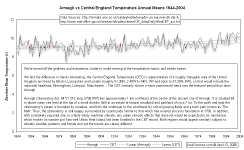 There are regions where temperature records have been maintained for much longer
than the 1880 commencement usually seen and these make interesting comparators. Additionally, we have some available rural and urban records from similar
regions that can be viewed in parallel where we might expect similar trends if urban influence has genuinely been removed from the record. Alongside we have an
example of the Armagh Observatory and Central England Temperature trends compared. Since there is no obvious reason carbon dioxide would behave differently in
Northern Ireland than it does in Central England we must at least entertain the suspicion other factors are in play.
There are regions where temperature records have been maintained for much longer
than the 1880 commencement usually seen and these make interesting comparators. Additionally, we have some available rural and urban records from similar
regions that can be viewed in parallel where we might expect similar trends if urban influence has genuinely been removed from the record. Alongside we have an
example of the Armagh Observatory and Central England Temperature trends compared. Since there is no obvious reason carbon dioxide would behave differently in
Northern Ireland than it does in Central England we must at least entertain the suspicion other factors are in play.
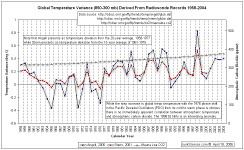 In addition to relatively subtle disparity in trends between locations we have
measurements which are likely less influenced by UHIE, those taken actually in the atmosphere by instrument packs carried aloft by meteorological balloons. At
left is the CDIAC radiosonde record from 1958-2004.
In addition to relatively subtle disparity in trends between locations we have
measurements which are likely less influenced by UHIE, those taken actually in the atmosphere by instrument packs carried aloft by meteorological balloons. At
left is the CDIAC radiosonde record from 1958-2004.
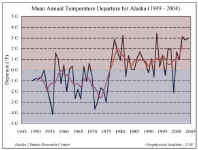 At
right we have the Alaskan surface record classically highlighting the effect of the PDO phase shift. There is no plausible means by which accumulating
greenhouse gas could effectively act as a major warming agent in one year but not in the preceding or subsequent years. There are many other datasets and
attempts at measuring the temperature of the Earth ranging from satellite-mounted Microwave Sounding Units (MSUs) to meteorological station near-surface
thermometer records and a comprehensive collection of these can be found here on JunkScience.com.
At
right we have the Alaskan surface record classically highlighting the effect of the PDO phase shift. There is no plausible means by which accumulating
greenhouse gas could effectively act as a major warming agent in one year but not in the preceding or subsequent years. There are many other datasets and
attempts at measuring the temperature of the Earth ranging from satellite-mounted Microwave Sounding Units (MSUs) to meteorological station near-surface
thermometer records and a comprehensive collection of these can be found here on JunkScience.com.
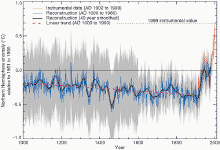 We would be remiss if we did not at least mention the infamous "hockey stick" representation of global
temperature as estimated for Earth's recent history. The graphic linked at left comes from the IPCC's Third Assessment Report (TAR). The red "blade" section of the graphic is the same
data as depicted in red on the graphic linked below, right and serves as an object lesson - always check the scale of depiction.
We would be remiss if we did not at least mention the infamous "hockey stick" representation of global
temperature as estimated for Earth's recent history. The graphic linked at left comes from the IPCC's Third Assessment Report (TAR). The red "blade" section of the graphic is the same
data as depicted in red on the graphic linked below, right and serves as an object lesson - always check the scale of depiction.
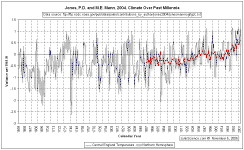 Notice that the graphic does not show
absolute Central England Temperature as does the Armagh comparison above. Of particular significance is that the CET contains abrupt warming episodes of similar
or greater magnitude early in each of the previous centuries. While it appears that the CET makes a fair proxy for Northern Hemisphere temperatures as derived
by Jones and Mann this is merely speculative and constitutes no proof. It does, however, suggest great caution is warranted before attempting to extrapolate
trends from a mere century or so of temperature data.
Notice that the graphic does not show
absolute Central England Temperature as does the Armagh comparison above. Of particular significance is that the CET contains abrupt warming episodes of similar
or greater magnitude early in each of the previous centuries. While it appears that the CET makes a fair proxy for Northern Hemisphere temperatures as derived
by Jones and Mann this is merely speculative and constitutes no proof. It does, however, suggest great caution is warranted before attempting to extrapolate
trends from a mere century or so of temperature data.
So, humans aren't affecting the planet or its temperature.
Remember:
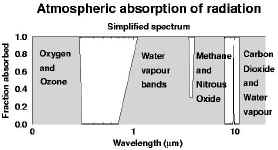 Here's a very simplified graphic on atmospheric absorption. And, at right, there's a somewhat more detailed graphic.
Here's a very simplified graphic on atmospheric absorption. And, at right, there's a somewhat more detailed graphic.
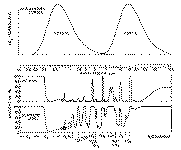 Right: (a) Normalized blackbody curves for 5780 K and 220 K, plotted so that irradiance is proportional to the areas
under the curves. (c) Atmospheric absorption in clear air for solar radiation with a zenith angle of 50 degrees and for diffuse terrestrial radiation. (b) Same
as (c) but for the portion of the atmosphere lying above the 11-km level, near the middle latitude tropopause. [From Wallace and Hobbs, p. 332]
Right: (a) Normalized blackbody curves for 5780 K and 220 K, plotted so that irradiance is proportional to the areas
under the curves. (c) Atmospheric absorption in clear air for solar radiation with a zenith angle of 50 degrees and for diffuse terrestrial radiation. (b) Same
as (c) but for the portion of the atmosphere lying above the 11-km level, near the middle latitude tropopause. [From Wallace and Hobbs, p. 332]
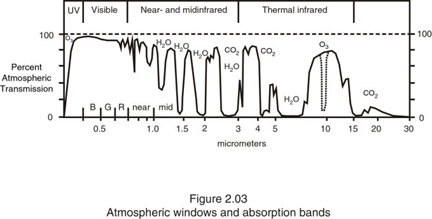
What are the take-home messages:
